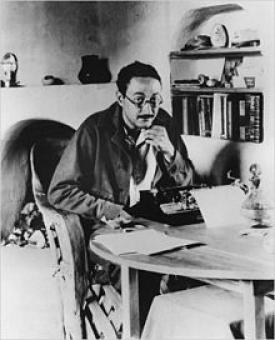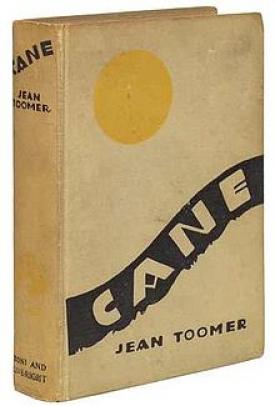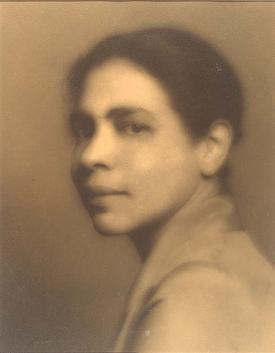You are here
Searching for a new soul in Harlem
Allyson Hobbs on passing and racial ambiguity during the Harlem Renaissance
 Harlem in the 1920s is known for its creative outpouring of art, music, and literature. A consciously political movement, the Harlem Renaissance was a cultural response to the dehumanizing limitations of Jim Crow, blackface minstrelsy, and economic disenfranchisement.
Harlem in the 1920s is known for its creative outpouring of art, music, and literature. A consciously political movement, the Harlem Renaissance was a cultural response to the dehumanizing limitations of Jim Crow, blackface minstrelsy, and economic disenfranchisement.
Early-20th-century America was organized along strict racial demarcations within a white supremacist world. Black authors like Alain Locke promoted a vision of the empowered “New Negro,” imbued with race pride. Ironically, during the same era that explicitly embraced a black identity, an extensive audience grew for literature focused on racial passing - stories about individuals of mixed-race heritage who passed as white.
For historian Allyson Hobbs, passing literature “functioned as a literary vehicle to critique racism and to draw attention to the absurdity of the American racial condition." Yet, Hobbs also asserts that passing "opened a space for a fuller consideration of complex relationships within African American group identity.”
In this moment of celebrating African American culture, Jean Toomer and Nella Larsen, literary luminaries in the Harlem Renaissance, struggled with definitions of race. As individuals with mixed European and African ancestry, race structured the ways others saw them and shaped the choices available to them. Hobbs examines their personal and professional writings to argue for the diversity of mixed-race experiences and self-identities, which have largely been obscured or forgotten in the literature on passing.
Finding new language for mixed-race identities
 Jean Toomer wrote as part of and in response to the writers of the Harlem Renaissance. He explored his own racial identity and the meaning of race, and finally attempted to disrupt racial categorization. Toomer was a racially ambiguous individual, with European ancestors and deep African American roots in the Washington, D.C., black elite. Toomer regularly confronted the question of “who and also what” he was. Toomer initially embraced an explicity black identity, particularly after a trip to the South inspired him to describe himself as “body and soul, Negro.” His experimental novel and poetry collection, "Cane," focused on traditional African American culture in the South, and was acclaimed by both black and white audiences. In "Cane," Hobbs sees Toomer as defining racial identity through shared experiences, culture, music, and speech, rather than simply skin color.
Jean Toomer wrote as part of and in response to the writers of the Harlem Renaissance. He explored his own racial identity and the meaning of race, and finally attempted to disrupt racial categorization. Toomer was a racially ambiguous individual, with European ancestors and deep African American roots in the Washington, D.C., black elite. Toomer regularly confronted the question of “who and also what” he was. Toomer initially embraced an explicity black identity, particularly after a trip to the South inspired him to describe himself as “body and soul, Negro.” His experimental novel and poetry collection, "Cane," focused on traditional African American culture in the South, and was acclaimed by both black and white audiences. In "Cane," Hobbs sees Toomer as defining racial identity through shared experiences, culture, music, and speech, rather than simply skin color.
 Over the next seven years, Toomer chafed more at the restrictions of strict racial categorization. By 1930, he rejected inclusion in black anthologies, and distanced himself from a black identity. Hobbs highlights how Toomer described his writing as having “taken Negro as a point, and from there have circled out.” Both his contemporaries and later scholars, including Henry Louis Gates, have simply described Toomer as “passing for white.” Yet Toomer, while distancing himself from blackness, never asserted a white identity.
Over the next seven years, Toomer chafed more at the restrictions of strict racial categorization. By 1930, he rejected inclusion in black anthologies, and distanced himself from a black identity. Hobbs highlights how Toomer described his writing as having “taken Negro as a point, and from there have circled out.” Both his contemporaries and later scholars, including Henry Louis Gates, have simply described Toomer as “passing for white.” Yet Toomer, while distancing himself from blackness, never asserted a white identity.
In Hobbs’ description, “Toomer’s dilemma underscores a core problem in racially indeterminate identities—not only was the language to express a mixed-race identity sparse, but a person who claimed a racially indeterminant identity could be perceived as false and misguided.” Toomer’s writing declined after he worked against his Negro categorization, and he retired, while not explicitly passing as white, in solely white company. In the historical record, Toomer has remained fixed despite his frustrated attempts to widen the categorical circles of selfhood. With her research, Hobbs seeks to restore the complexity of Toomer’s self-definition.
Facing fixed race categories
 Nella Larsen, Hobbs points out, also sought to assert her own path but was trapped by the intersections of race and gender. As a mixed-race author who highlighted issues of passing in her literature, Larsen depicted individuals in situations similar to her own as “strangled by an inflexible and unforgiving racial and gendered regime.”
Nella Larsen, Hobbs points out, also sought to assert her own path but was trapped by the intersections of race and gender. As a mixed-race author who highlighted issues of passing in her literature, Larsen depicted individuals in situations similar to her own as “strangled by an inflexible and unforgiving racial and gendered regime.”
Unlike Toomer, who was raised with a strong familial sense of kin and lineage, Larsen was traumatized by the effects of racial demarcation in her own upbringing. Her white mother distanced herself from Larsen after ending a relationship with Larsen’s father, a West Indian man. Larsen had no familial ties to the South, long a central and historic cultural site for African Americans, and lacked any personal sense of who “her people,” European or West Indian, might be. Larsen’s female characters struggled without success against gender norms, stymied in their attempts at self-fashioning.
Both Toomer and Larsen, Hobbs argues, experienced a lack of nuanced racial vocabulary as well as a dearth of ready listeners. Yet their responses differed. Larsen “accepted racial categories,” Hobbs explains, because “race had over-determined her life circumstances, severed her familial relationships, and heightened her emotional and professional insecurities.” In contrast, Toomer attempted to chart his own racial path, rejecting the binary racial categories that both black and white contemporaries put on him. Despite the struggles of eloquent artists, Jim Crow proved “too sturdy.” The racial divide remained rigid until the close of the century.
Initially structuring her project around the history of passing, Hobbs reframed her work around the “problem of racial indeterminacy,” which “lies at the core of passing; it is the precondition that makes passing possible.” Hobbs explains that she realized focusing exclusively on passing overlooked or oversimplified individuals who resisted categorization as black or Negro, but who also never assumed a white identity. Simply put, Hobbs argues, “To disavow a black racial identity did not necessarily mean to pass as white.”
--------------------------
 Allyson Hobbs is an assistant professor of history at Stanford University and a Clayman Institute Faculty Research Fellow. She graduated from Harvard and received a Ph.D. from the University of Chicago. Hobbs teaches courses on African American history, African American women’s history and 20th century American history. Her research interests include American social and cultural history, racial mixture, identity formation, migration and urbanization, and the intersections of race, class and gender.
Allyson Hobbs is an assistant professor of history at Stanford University and a Clayman Institute Faculty Research Fellow. She graduated from Harvard and received a Ph.D. from the University of Chicago. Hobbs teaches courses on African American history, African American women’s history and 20th century American history. Her research interests include American social and cultural history, racial mixture, identity formation, migration and urbanization, and the intersections of race, class and gender.
Annelise Heinz is a Ph.D. candidate in the Department of History. Her work focuses on the intersections of race, gender, and sexuality in American and transpacific history. She writes as part of the Clayman Institute Student Writing Team.
Categories
- Academia (196)
- Art & Literature (83)
- Featured (5)
- History (49)
- Influential Voices (23)
- Law (24)
- Leadership & Advocacy (173)
- Medicine & Science (60)
- Negotiation (4)
- Policy & Government (84)
- Technology (35)
- Uncategorized (4)
- Work & Career (132)
